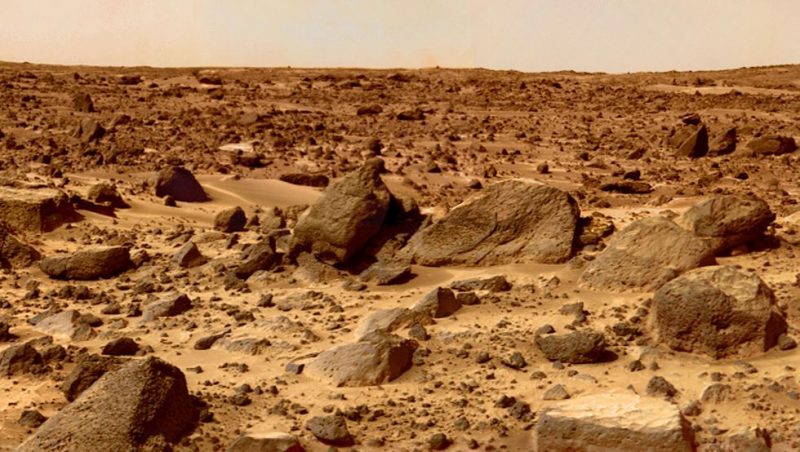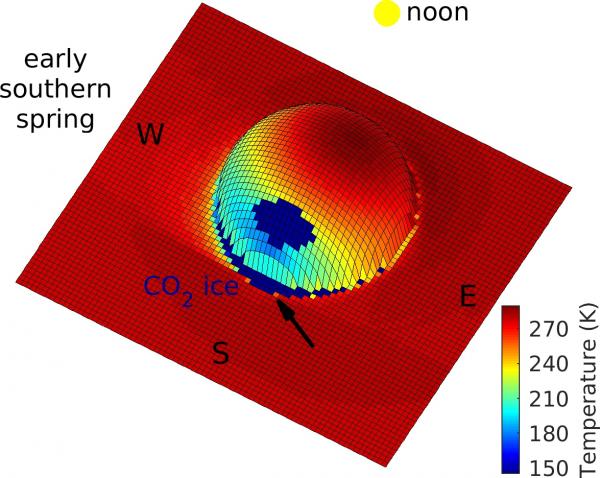

Field of large boulders as seen by the Mars Pathfinder lander on Mars in 1997. A new study suggests that small pools of liquid water may be able to briefly form in the shadows of such boulders at mid-latitudes in the springtime. Image via NASA/ JPL-Caltech/ Popular Mechanics.
Mars is a cold, very dry, desert world. Although it has ice caps of water ice (as well as carbon dioxide ice) and vast amounts of ice below its surface, no liquid water has been found on Mars’ surface. But there might be some. We might just need to look behind large boulders, in springtime.
A new study from the Planetary Science Institute (PSI) in Tucson, Arizona – announced on February 12, 2020 – adds to previous evidence that small amounts of briny (salty) water might be able to form on the Martian surface under just the right conditions.
The new peer-reviewed paper, by planetary scientist Norbert Schorghofer at PSI, was published in The Astrophysical Journal on February 12.
From the paper:
The possibility of liquid water on present-day Mars has been debated for half a century. Melting is physically difficult under Martian environmental conditions, because with the total pressure of the atmosphere near the triple point pressure of water, evaporative cooling of ice is high near the melting point.
According to the study, the briny water might be possible for only a few days of each Martian year. The trick is that this can only happen under just the right circumstances. Schorghofer said:
Mars has plenty of cold ice-rich regions and plenty of warm ice-free regions, but icy regions where the temperature rises above the melting point are a sweet spot that is nearly impossible to find. That sweet spot is where liquid water would form.

Three-dimensional computerized view of the Martian surface temperature around a boulder at latitude 30° south. On the side opposite to the sun, temperatures are around -128 degrees Celsius. As the sun rises, this area heats up rapidly, melting frost on the salty ground. This could briefly create small amounts of briny water that later goes back into the atmosphere, via sublimation. Image via Norbert Schorghofer/ PSI.
This sweet spot would involve protruding topography, such as boulders, at mid-latitudes. During the winter, a boulder might cast a continual shadow, where water ice can accumulate as frost. When spring came again, the temperature can increase quite quickly. In the computer models used, temperature would rise from -198° Fahrenheit (-128° Celsius) in the morning to -14° Fahrenheit (-10° Celsius) at noon. That is a short enough time that not all the frost would sublimate – pass directly from the solid to vapor state – as it normally does in the very thin, cold atmosphere. From the paper:
Protruding topography creates locations that experience a rapid transition from conditions where water frost accumulates to high solar energy input. Beyond the pole-facing side of a boulder, carbon dioxide and water frost can accumulate seasonally, and once the sun reemerges and the carbon dioxide frost disappears, the water frost is heated to near melting temperature within one or two sols [days on Mars].
The scientists said it is dust within the carbon dioxide frost that helps keep it from sublimating back into the atmosphere as temperatures rise. From the paper:
Overall, melting of pure water ice is not expected under present-day Mars conditions. However, at temperatures that are readily reached, seasonal water frost can melt on a salt-rich substrate.
The whole cycle would repeat, year after Martian year.

In 2008, what appeared to be small drops of briny liquid water were seen on the legs of the Phoenix Mars Lander. These images show changes in the drops over 36 days. Image via Renno et al./ NASA/ Space.com.
As mentioned above, carbon dioxide ice can also form behind large boulders on Mars. That ice, too, will sublimate in the spring. Scientists have a name for the first day in spring when the carbon dioxide ice disappears. They call it the crocus date.
Water ice melting also occurs either on or just after that date. Thus it is referred to as crocus melting. According to Schorghofer:
Answering the question whether crocus melting of seasonal water ice actually occurs on Mars required a slew of detailed quantitative calculations, the numbers really matter. It took decades to develop the necessary quantitative models.
Today, Mars’ atmosphere is too cold and too thin for water to last long on the surface, even briny water. But there have been other hints that it may occur when conditions are right.
The famous recurring slope lineae on Mars may be evidence of seasonal briny water on Mars. The slope linae are dark streaks that occur on steep slopes during the warmer months and keep recurring in the same locations each year. It still isn’t known exactly what causes them, but theories have ranged from small amounts of flowing briny water to dust slides. If water is involved – not a certainty yet – it could come from the atmosphere, ice pockets or subsurface aquifers.

Norbert Schorghofer at the Planetary Science Institute. Image via Planetary Science Institute.
During the Mars Phoenix Lander mission, which landed near the north pole in 2008, images showed small droplets forming on the legs of the spacecraft. While not proven, they certainly looked like drops of briny water that later sublimated away.
Last year, NASA’s InSight lander found possible evidence of current reservoirs of liquid water below the surface. If confirmed, that would be an exciting discovery, in particular for the potential of subsurface life, which would be protected from the severe conditions on the surface. In 2018, it was announced that the European Space Agency’s Mars Express orbiter had found evidence of a salty subsurface lake beneath the ice at the south pole.
If there really are brief pools of liquid water hiding behind Martian boulders at times, that also would be exciting, as Mars would then be the only place other than Earth in our solar system where water would be known to be able to exist on the surface. This could have significant implications for the possibility of microbial life on an otherwise dry and hostile world.
Bottom line: A new study from the Planetary Research Institute suggests that briny water could temporarily form on Mars’ surface under certain conditions.
Source: Mars: Quantitative Evaluation of Crocus Melting behind Boulders
Via Planetary Science Institute
from EarthSky https://ift.tt/2SvdB4M


Field of large boulders as seen by the Mars Pathfinder lander on Mars in 1997. A new study suggests that small pools of liquid water may be able to briefly form in the shadows of such boulders at mid-latitudes in the springtime. Image via NASA/ JPL-Caltech/ Popular Mechanics.
Mars is a cold, very dry, desert world. Although it has ice caps of water ice (as well as carbon dioxide ice) and vast amounts of ice below its surface, no liquid water has been found on Mars’ surface. But there might be some. We might just need to look behind large boulders, in springtime.
A new study from the Planetary Science Institute (PSI) in Tucson, Arizona – announced on February 12, 2020 – adds to previous evidence that small amounts of briny (salty) water might be able to form on the Martian surface under just the right conditions.
The new peer-reviewed paper, by planetary scientist Norbert Schorghofer at PSI, was published in The Astrophysical Journal on February 12.
From the paper:
The possibility of liquid water on present-day Mars has been debated for half a century. Melting is physically difficult under Martian environmental conditions, because with the total pressure of the atmosphere near the triple point pressure of water, evaporative cooling of ice is high near the melting point.
According to the study, the briny water might be possible for only a few days of each Martian year. The trick is that this can only happen under just the right circumstances. Schorghofer said:
Mars has plenty of cold ice-rich regions and plenty of warm ice-free regions, but icy regions where the temperature rises above the melting point are a sweet spot that is nearly impossible to find. That sweet spot is where liquid water would form.

Three-dimensional computerized view of the Martian surface temperature around a boulder at latitude 30° south. On the side opposite to the sun, temperatures are around -128 degrees Celsius. As the sun rises, this area heats up rapidly, melting frost on the salty ground. This could briefly create small amounts of briny water that later goes back into the atmosphere, via sublimation. Image via Norbert Schorghofer/ PSI.
This sweet spot would involve protruding topography, such as boulders, at mid-latitudes. During the winter, a boulder might cast a continual shadow, where water ice can accumulate as frost. When spring came again, the temperature can increase quite quickly. In the computer models used, temperature would rise from -198° Fahrenheit (-128° Celsius) in the morning to -14° Fahrenheit (-10° Celsius) at noon. That is a short enough time that not all the frost would sublimate – pass directly from the solid to vapor state – as it normally does in the very thin, cold atmosphere. From the paper:
Protruding topography creates locations that experience a rapid transition from conditions where water frost accumulates to high solar energy input. Beyond the pole-facing side of a boulder, carbon dioxide and water frost can accumulate seasonally, and once the sun reemerges and the carbon dioxide frost disappears, the water frost is heated to near melting temperature within one or two sols [days on Mars].
The scientists said it is dust within the carbon dioxide frost that helps keep it from sublimating back into the atmosphere as temperatures rise. From the paper:
Overall, melting of pure water ice is not expected under present-day Mars conditions. However, at temperatures that are readily reached, seasonal water frost can melt on a salt-rich substrate.
The whole cycle would repeat, year after Martian year.

In 2008, what appeared to be small drops of briny liquid water were seen on the legs of the Phoenix Mars Lander. These images show changes in the drops over 36 days. Image via Renno et al./ NASA/ Space.com.
As mentioned above, carbon dioxide ice can also form behind large boulders on Mars. That ice, too, will sublimate in the spring. Scientists have a name for the first day in spring when the carbon dioxide ice disappears. They call it the crocus date.
Water ice melting also occurs either on or just after that date. Thus it is referred to as crocus melting. According to Schorghofer:
Answering the question whether crocus melting of seasonal water ice actually occurs on Mars required a slew of detailed quantitative calculations, the numbers really matter. It took decades to develop the necessary quantitative models.
Today, Mars’ atmosphere is too cold and too thin for water to last long on the surface, even briny water. But there have been other hints that it may occur when conditions are right.
The famous recurring slope lineae on Mars may be evidence of seasonal briny water on Mars. The slope linae are dark streaks that occur on steep slopes during the warmer months and keep recurring in the same locations each year. It still isn’t known exactly what causes them, but theories have ranged from small amounts of flowing briny water to dust slides. If water is involved – not a certainty yet – it could come from the atmosphere, ice pockets or subsurface aquifers.

Norbert Schorghofer at the Planetary Science Institute. Image via Planetary Science Institute.
During the Mars Phoenix Lander mission, which landed near the north pole in 2008, images showed small droplets forming on the legs of the spacecraft. While not proven, they certainly looked like drops of briny water that later sublimated away.
Last year, NASA’s InSight lander found possible evidence of current reservoirs of liquid water below the surface. If confirmed, that would be an exciting discovery, in particular for the potential of subsurface life, which would be protected from the severe conditions on the surface. In 2018, it was announced that the European Space Agency’s Mars Express orbiter had found evidence of a salty subsurface lake beneath the ice at the south pole.
If there really are brief pools of liquid water hiding behind Martian boulders at times, that also would be exciting, as Mars would then be the only place other than Earth in our solar system where water would be known to be able to exist on the surface. This could have significant implications for the possibility of microbial life on an otherwise dry and hostile world.
Bottom line: A new study from the Planetary Research Institute suggests that briny water could temporarily form on Mars’ surface under certain conditions.
Source: Mars: Quantitative Evaluation of Crocus Melting behind Boulders
Via Planetary Science Institute
from EarthSky https://ift.tt/2SvdB4M

Aucun commentaire:
Enregistrer un commentaire